Mollusks
PHYLUM MOLLUSCA
The second largest phylum, Mollusca (soft bodied animals), has more than 100,000 living described species. Its classes include bivalves (Pelecypoda), snails (Gastropoda), chitons, squids, and octopuses. Mollusk body plans are all similar. Most have a fleshy foot, a mantle, one or more gills, a radula (tongue), and a hard protective shell. The hard shell is not an important characteristic as there are hard-shelled animals in other phyla.
A Mollusk shell, produced by glands in the mantle, has three layers. A dark horny outer covering, or periostracum, protects the shell and the hinge ligament of bivalves, and prevents calcium in the shell from being dissolved by carbonic acid in the water. The middle or prismatic layer of the shell is composed largely of two or more crystalline forms of calcium carbonate. The innermost or pearly layer is formed of sheets of calcium carbonate laid down parallel to the surface. The outer layers are secreted at the edge of the mantle. The layers are separated by a protein, called conchiolin, that also forms the ligament. In addition to the inorganic salts in the shell, there is a matrix of protein that helps to bind the crystals.
CLASS PELECYPODA
This class includes the bivalves: clams, oysters, mussels and scallops. Their shells are fastened by a ligament on the back edge. An elevated knob called the umbone or umbo is near the ligament.
The end of the animal nearer the umbone is the anterior or front. Bivalves are filter feeders. Cilia in the gills beat rhythmically to bring water in. Oxygen is absorbed by the gills and the mantle.
Food is extracted both by mucous and cilia in specialized areas of the mantle. Carbon dioxide and wastes are eliminated in the excurrent water stream.
Although bivalves can remain closed for lengthy periods, particularly when under attack by predators, they must eventually open their shells to eliminate carbon dioxide, that is poisonous when its concentration rises above certain limits. The same reflex occurs in humans. Holding one's breath is limited more because of too much carbon dioxide rather than too little oxygen.
HARD SHELL CLAM: Mercenaria mercenaria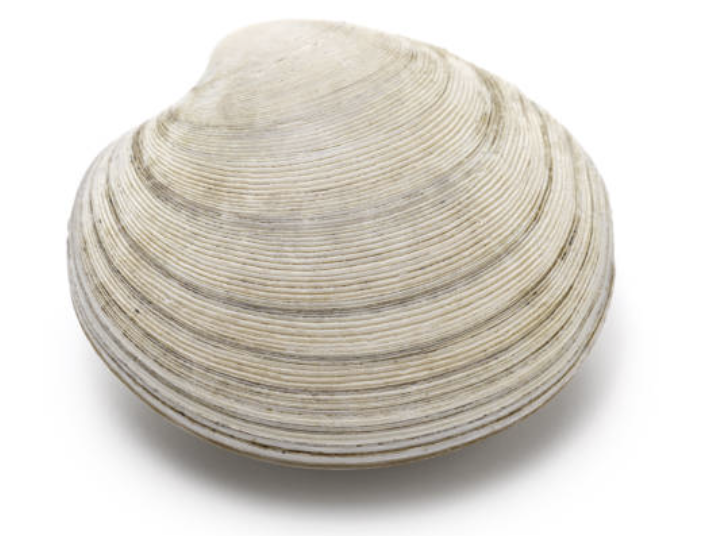
The quahog, round or hard shell clam is known by the market names little neck, cherrystone and chowder, depending on size. Clams bury themselves almost completely in sandy or muddy bottom with their heads (anterior end) down. The foot is anterior. The incoming and outgoing water siphons are posterior where they can remain above bottom sediments. An average size individual pumps 2.5 liters of water per hour, about 15 gallons per day, using cilia in the gills.
Movement:
A clam is usually sedentary, but can move by extending its foot and pulling itself along. This movement is not fast enough for it to escape predators, but can allow it to move to a more favorable location.
Reproduction:
Clams have two sexes. Eggs and sperm are expelled into the water column where fertilization and further development takes place. One of the larval stages, called the veliger, can swim and thereby can extend the range of its parents.
Food:
The clam is a filter feeder. It extracts food from the plankton that pass over its body in the course of respiration.
Predators:
Larva and young clams are food for many other animals. Larger clams are preyed on by fish such as tautog, .skates and rays. These predators are equipped with mouth parts or teeth adapted to crack their shells. They are also seriously attacked by sea stars, whelks and other snails.
Age:
These clams grow quickly when young, reaching 2-3" in three to four years, but more slowly after that. They may live 20-25 years after reaching maximum growth of about 4".
Interesting Facts:
Native Americans used clam shells as wampum (money). The blue or purple portion of the inside of the shell was considered more valuable, and was often used for decoration as well as for money.
SOFT SHELL CLAM: Mya arenaria
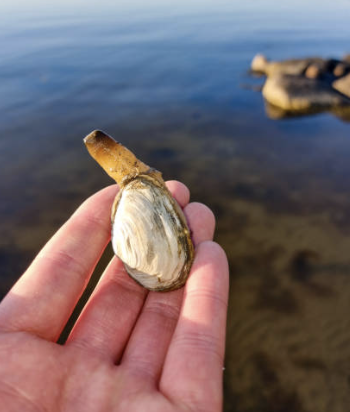
Soft clam shells are considerably thinner than the hard shelled variety. The valves do not meet tightly except at the ligament and on the opposite edge, the ventral side. At the posterior end the shells are permanently open for the large siphon to pass through. The siphon that takes in and expels water is not withdrawn into the body. This clam stays under the surface of mud or sand, extends its siphon when covered with water, and withdraws it at low tide when it becomes uncovered.
Interesting Facts:
In the Boston area this animal is known as a "clam". Around Norwalk it is called a "steamer." s will know it as the clam that spits when one walks along the shore or on the mud flats.
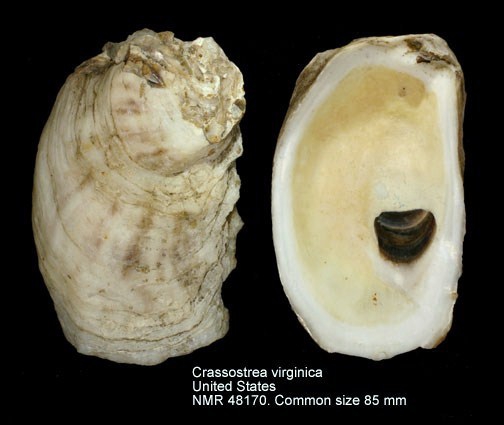
EASTERN OYSTER: Crassostrea virginica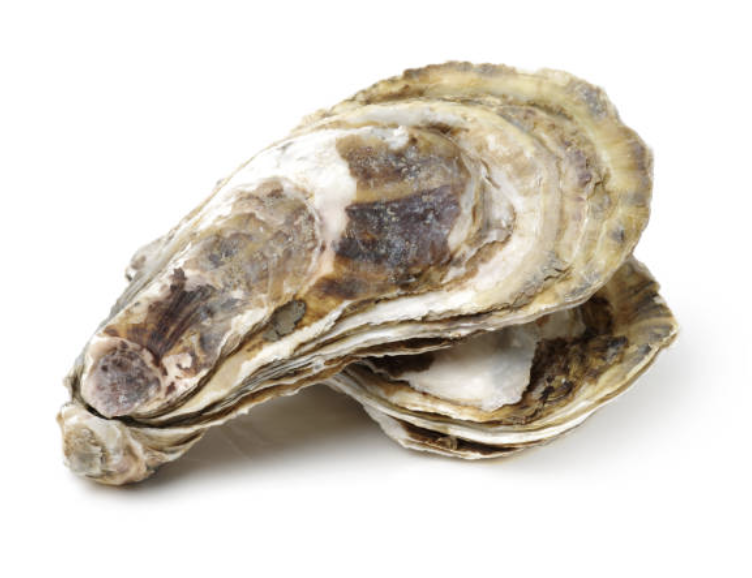
Although there are several species of oyster that live in the ocean or are cultivated elsewhere than in Long Island Sound, the eastern oyster is known as the Blue Point, Chincoteague, Appalachicola, etc. depending on where it was reared. In talking about oysters it is helpful to remember that the flatter valve is the right side and the head or anterior end is at the narrow portion. Oysters are always attached on their left shell, usually with their heads down.
Reproduction:
Oysters are protandric, meaning that in their first year most function as males. After spawning, both sexes enter an undifferentiated state from which, in subsequent years, they can be either male or female. The determination appears to depend on external factors such as the size of the oyster, how near it is to other males or females, and the quality of the food supply. They do not change sex during the year, but some species of oyster change more than once in subsequent years: some never change.
Oysters become sexually mature during their first year. A large female oyster may produce as many as 5 to 10 million eggs at each spawning, and may do so several times a year. At the same time, or slightly ahead, the male produces sperm so the excess in the water column facilitates fertilization. Eggs are microscopic in size.
Spawning begins when the water reaches about 68° with the high point of the season at 72°. Spawning takes place several times a year. Fertile eggs drop to the bottom. A European species (Ostrea edulis ) is ovoviviparous, meaning that the female holds eggs in her mantle until they hatch and the larvae can swim away.
Larval Development:
4 hours after fertilization the shell rudiments appear at one end of the egg, cilia (movable hairs) appear at the other. The oyster larva then swims up near the surface where it can find microscopic food particles. The swimming form is called a veliger. It has all the necessary parts to be an oyster, but development continues for the next 15 to 20 days while the veligers scatter throughout the water column. At the end of its swimming period the veliger looks is smaller than a grain of rice. When the veliger settles to the bottom it attaches what will become its left valve to some hard clean support using a permanent cement. The young attached oyster is called spat. Veligers can become spat for only a limited time after the first 15 days. The process is dependent on water temperature and environmental conditions. Most veligers are eaten by other animals or die naturally after failing to attach themselves. Sea stars and comb jellies, as well as many other animals, prey on larval oysters.
Age:
After three months, the spat is about the size of a dime. Oysters may live to be 12 years old but reach their maximum reproductive potential between 4 and 7 years. Shell is built in spring and early fall leaving bands measuring 1/2" to 3/8". Counting two bands per year can give some idea of the animal's age, but is not necessarily exact.
Vision;
Oysters are sensitive to light. An open oyster bathed in sunlight will close if a shadow passes over it.
Predators:
Whelks, sea stars and drills are the predominant predators on Long Island Sound oyster beds. The Oyster Drill (Urosalpinx cinerea ) and the Thick-Lip Drill (Eupleura caudata ) leave perforations in the shell that are narrow toward the inside.
Interesting Facts:
Oysters have blue blood. Their corpuscles contain cyanoglobin, a copper containing molecule. Red human blood, in contrast, contains hemoglobin, an iron containing molecule.
Cilia or moveable hairs on internal surfaces sweep water through the body cavities. Oxygen and carbon dioxide are exchanged and curtain-like members covered with sticky mucus trap plankton and other edible materials. Adult oysters may pump as much as 6-7 gallons of water per hour, but they do not pump continuously. The pumping rate depends on the amount of food available and the water temperature among other variables. An oyster can filter up to 30 gallons of water a day, which makes them an extremely important species for water quality.
Oysters may produce pearls if some irritating substance inside the mantle cannot be discharged.
BLUE MUSSEL: Mytilus edulis
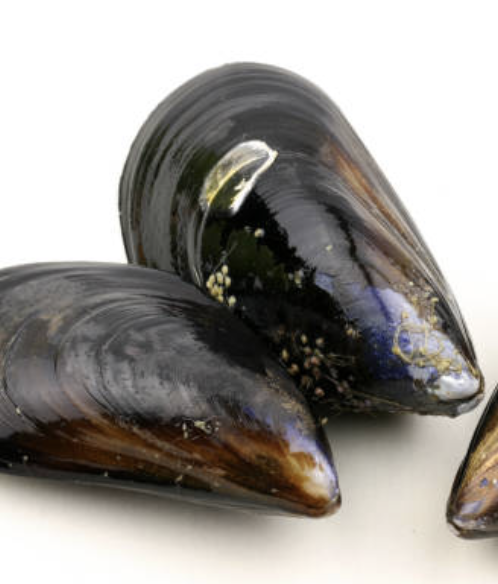
Blue mussels may be found attached to rocks, to pilings and to each other in beds where water movement brings nutrients. They attach themselves with strong, orange colored filaments called byssus threads that are produced from glands in the foot. As with other pelecypods, a young mussel can move slowly to a more favorable location by using its muscular foot. In older mussels the foot is used for the production of protein to make byssus threads. Older animals can move by casting out byssus threads and pulling with internal muscles.
Reproduction:
Mussels have separate sexes. They reproduce by expelling eggs and sperm into the water column where the two meet to become fertilized. This spawning takes place in late winter or early spring. Female mussels can produce 10-20 million eggs in a season. Pheromones expelled with the eggs stimulate male sperm production and act as attractants to the larval forms that are looking for a place to settle.
Growth:
Mussels add shell along the outer edges as they grow. Shell building takes place in spring and fall while the animal is not busy making eggs or sperm. Each addition leaves a mark so the mussel's age can be determined approximately by counting the annual groups and dividing by two.
Interesting Facts:
Mussels can filter nearly 25 gallons of water a day. This large volume brings with it not only planktonic nutrients, but pollutants and poisons that may be in the water. When these toxins are stored in the body, the mussel may be poisonous if eaten. Mussel, clam and oyster beds are carefully monitored to make sure none are taken if they can be harmful.
RIBBED MUSSEL: Modiolus demissus
Looking similar in shape to the blue mussel, the ribbed is characterized by radial lines in the shell that start at the apex and a yellowish brown or greenish periostracum. The ribbed mussel lives in muddy bottoms and particularly in the reed beds of salt marshes, where it is well protected. Except for the ribs, Modiolus and Mytilus differ mostly in the shape of the apex or pointed end of the shell. The ribbed mussel may be dangerous to eat because it is often associated with species of toxic blue-green algae.
CLASS GASTROPODA
The class Gastropoda (meaning stomach foot), containing the snails, has more than 35,000 species. In general gastropods have a flat foot for creeping and a distinct head with eyes and tentacles. Usually they have a one piece shell. Most lay eggs. Larvae emerge as veligers, free swimming planktonic forms.
Gastropods retain the same shell all their lives, adding new material at the edge of the opening by means of glands on the body and, for lining the inside of the shell, from glands on the mantle.
Snails have tentacles on each side of the head that appear to be mainly sensitive to touch and chemicals. There may also be light sensitive eyes somewhere along the tentacles.
CHANNELED WHELK: Busycotypus canaliculatus
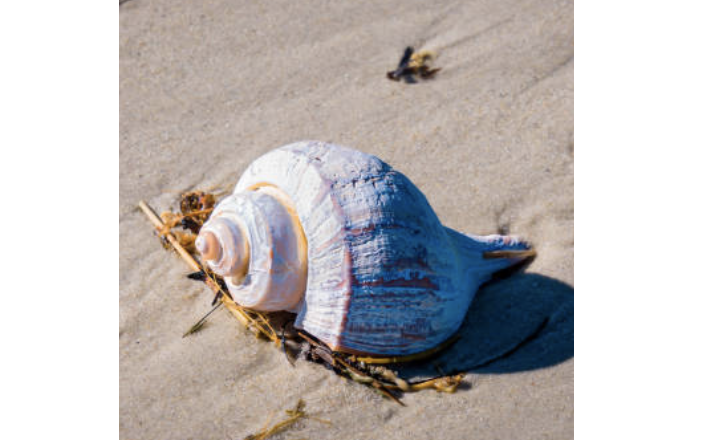
This is the common whelk in this part of the Sound and at the Maritime Aquarium. In restaurants it is served as scungilli. It eats bivalves, carrion, other snails and other whelks. A whelk can hold an oyster with its foot and chip off the edge of the shell to make a hole big enough to get its radula (tongue) inside. A whelk may also insert its shell or mantle in an open bivalve to keep it from closing. The radula is long, covered with hard teeth to tear its prey and transport it into its mouth. The radula may carry digestive enzymes that make ingestion easier and faster.
Age:
As whelks grow they make more shell as needed. The visible lines on the outside of the shell do not represent any particular season or timing pattern, and it is not possible to determine the age of a whelk except by guess and experience.
Behavior:
Whelks generally live under the sand where they cruise in search of prey.
Vision:Whelks eyes are at the base of the tentacles. The spots at the ends are for touch and taste.
Enemies:Small whelks are eaten by other whelks, other snails, crabs, lobsters and some fish. When they become too large, they are less apt to become prey. Instead, they are formidable predators.
Reproduction: Most snails are hermaphrodites, meaning that both male and female sexual organs are present in each animal. Snails are not self-fertilizing. When snails meet, they exchange packets of sperm with which the eggs are subsequently fertilized. While buried in the sand, the spawning female whelk expels a soft egg case, capsule or packet about every two hours which may be empty or in which she may have deposited as many as 20 eggs, most of which can be fertile. The capsule hardens quickly in the salt water. Capsules, which have knife-like edges, are connected to a strong backbone or string that helps to keep them buried in the sand. After 90-120 days of development the embryos have matured. Now an enzyme forms to dissolve the proteinaceous cork sealing the egg capsule, and the veligers can escape. Newly hatched whelks resemble adults, except for size and ability to move about in the water column. They immediately look for shelter and food.
KNOBBED WHELK: Busycon carica
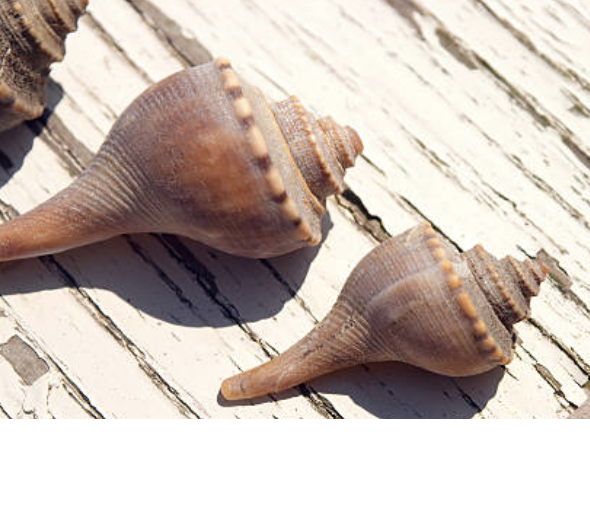
The knobbed whelk is not as common as the channeled whelk in the Norwalk area. The animals are similar in most respects except for the shapes both of their shells and their egg packets. Knobbed whelk packets have square edges, Channeled whelk packets have angular or knifelike edges. Knobbed whelks are likely to become larger than channeled whelks.
NORTHERN MOON SNAIL: Lunatia heros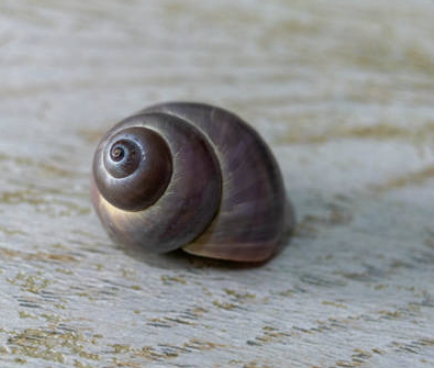
This snail, whose shell is most often displayed in the Touch Tank as a home for a hermit crab, is a predator on mollusks. Like the oyster drills it uses chemicals in the foot to soften the shells of prey, and the radula to abrade the softened material. The radula, accompanied by digestive juices, is inserted through the hole. Moon snails can grow up to 4" across.
Behavior: The moon snail lives under the surface of the sand where it cruises looking for prey. When its foot is extended, it is surprisingly large making it hard to believe that the whole animal can be withdrawn into the small shell. When fully extended, the mantle almost completely covers the shell.
Enemies: Moon snails are preyed on by whelks that can be considerably larger, stronger and quicker in their movements.